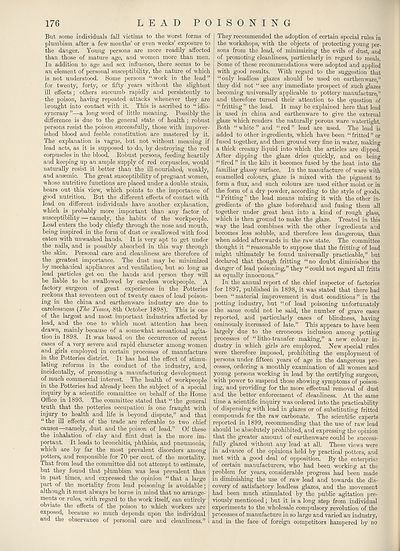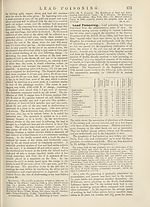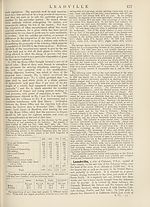New volumes of the Encyclopædia Britannica > Volume 30, K-MOR
(200) Page 176
Download files
Complete book:
Individual page:
Thumbnail gallery: Grid view | List view

LEAD POISONING
176
But some individuals fall victims to the worst forms of
plumbism after a few months’ or even weeks’ exposure to
the danger. Young persons are more readily affected
than those of mature age, and women more than men.
In addition to age and sex influence, there seems to be
an element of personal susceptibility, the nature of which
is not understood. Some persons “ work in the lead ”
for twenty, forty, or fifty years without the slightest
ill effects; others succumb rapidly and persistently to
the poison, having repeated attacks whenever they are
brought into contact with it. This is ascribed to “ idio¬
syncrasy ”—a long word of little meaning. Possibly the
difference is due to the general state of health ; robust
persons resist the poison successfully, those with impover¬
ished blood and feeble constitution are mastered by it.
The explanation is vague, but not without meaning if
lead acts, as it is supposed to do, by destroying the red
corpuscles in the blood. Robust persons, feeding heartily
and keeping up an ample supply of red corpuscles, would
naturally resist it better than the ill-nourished, weakly,
and anaemic. The great susceptibility of pregnant women,
whose nutritive functions are placed under a double strain,
bears out this view, which points to the importance of
good nutrition. But the different effects of contact with
lead on different individuals have another explanation,
which is probably more important than any factor of
susceptibility — namely, the habits of the workpeople.
Lead enters the body chiefly through the nose and mouth,
being inspired in the form of dust or swallowed with food
eaten with unwashed hands. It is very apt to get under
the nails, and is possibly absorbed in this way through
the skin. Personal care and cleanliness are therefore of
the greatest importance. The dust may be minimized
by mechanical appliances and ventilation, but so long as
lead particles get on the hands and person they will
be liable to be swallowed by careless workpeople. A
factory surgeon of great experience in the Potteries
reckons that seventeen out of twenty cases of lead poison¬
ing in the china and earthenware industry are due to
carelessness (The Times, 8th October 1898). This is one
of the largest and most important industries affected by
lead, and the one to which most attention has been
drawn, mainly because of a somewhat sensational agita¬
tion in 1898. It was based on the occurrence of recent
cases of a very severe and rapid character among women
and girls employed in certain processes of manufacture
in the Potteries district. It has had the effect of stimu¬
lating reforms in the conduct of the industry, and,
incidentally, of promoting a manufacturing development
of much commercial interest. The health of workpeople
in the Potteries had already been the subject of a special
inquiry by a scientific committee on behalf of the Home
Office in 1893. The committee stated that “the general
truth that the potteries occupation is one fraught with
injury to health and life is beyond dispute,” and that
“ the ill effects of the trade are referable to two chief
causes—namely, dust and the poison of lead.” Of these
the inhalation of clay and flint dust is the more im¬
portant. It leads to bronchitis, phthisis, and pneumonia,
which are by far the most prevalent disorders among
potters, and responsible for 70 per cent, of the mortality.
That from lead the committee did not attempt to estimate,
but they found that plumbism was less prevalent than
in past times, and expressed the opinion “that a large
part of the mortality from lead poisoning is avoidable;
although it must always be borne in mind that no arrange¬
ments or rules, with regard to the work itself, can entirely
obviate the effects of the poison to which workers are
exposed, because so much depends upon the individual
and the observance of personal care and cleanliness.”
They recommended the adoption of certain special rules in
the workshops, with the objects of protecting young per¬
sons from the lead, of minimizing the evils of dust, and
of promoting cleanliness, particularly in regard to meals.
Some of these recommendations were adopted and applied
with good results. With regard to the suggestion that
“only leadless glazes should be used on earthenware,”
they did not “see any immediate prospect of such glazes
becoming universally applicable to pottery manufacture,”
and therefore turned their attention to the question of
“ fritting ” the lead. It may be explained here that lead
is used in china and earthenware to give the external
glaze which renders the naturally porous ware watertight.
Both “ white ” and “ red ” lead are used. The lead is
added to other ingredients, which have been “ fritted ” or
fused together, and then ground very fine in water, making
a thick creamy liquid into which the articles are dipped.
After dipping the glaze dries quickly, and on being
“ fired ” in the kiln it becomes fused by the heat into the
familiar glassy surface. In the manufacture of ware with
enamelled colours, glaze is mixed with the pigment to
form a flux, and such colours are used either moist or in
the form of a dry powder, according to the style of goods.
“Fritting” the lead means mixing it with the other in¬
gredients of the glaze beforehand and fusing them all
together under great heat into a kind of rough glass,
which is then ground to make the glaze. Treated in this
way the lead combines with the other ingredients and
becomes less soluble, and therefore less dangerous, than
when added afterwards in the raw state. The committee
thought it “ reasonable to suppose that the fritting of lead
might ultimately be found universally practicable,” but
declared that though fritting “no doubt diminishes the
danger of lead poisoning,” they “could not regard all fritts
as equally innocuous.”
In the annual report of the chief inspector of factories
for 1897, published in 1898, it was stated that there had
been “ material improvement in dust conditions ” in the
potting industry, but “of lead poisoning unfortunately
the same could not be said, the number of grave cases
reported, and particularly cases of blindness, having
ominously increased of late.” This appears to have been
largely due to the erroneous inclusion among potting
processes of “ litho-transfer making,” a new colour in¬
dustry in which girls are employed. New special rules
were therefore imposed, prohibiting the employment of
persons under fifteen years of age in the dangerous pro¬
cesses, ordering a monthly examination of all women and
young persons working in lead by the certifying surgeon,
with power to suspend those showing symptoms of poison¬
ing, and providing for the more effectual removal of dust
and the better enforcement of cleanliness. At the same
time a scientific inquiry was ordered into the practicability
of dispensing with lead in glazes or of substituting fritted
compounds for the raw carbonate. The scientific experts
reported in 1899, recommending that the use of raw lead
should be absolutely prohibited, and expressing the opinion
that the greater amount of earthenware could be success-
fully glazed without any lead at all. These views were
in advance of the opinions held by practical potters, and
met with a good deal of opposition. By the enterprise
of certain manufacturers, who had been working at the
problem for years, considerable progress had been made
in diminishing the use of raw lead and towards the dis¬
covery of satisfactory leadless glazes, and the movement
had been much stimulated by the public agitation pre¬
viously mentioned; but it is a long step from individual
experiments to the wholesale compulsory revolution of the
processes of manufacture in so large and varied an industry,
and in the face of foreign competitors hampered by no
176
But some individuals fall victims to the worst forms of
plumbism after a few months’ or even weeks’ exposure to
the danger. Young persons are more readily affected
than those of mature age, and women more than men.
In addition to age and sex influence, there seems to be
an element of personal susceptibility, the nature of which
is not understood. Some persons “ work in the lead ”
for twenty, forty, or fifty years without the slightest
ill effects; others succumb rapidly and persistently to
the poison, having repeated attacks whenever they are
brought into contact with it. This is ascribed to “ idio¬
syncrasy ”—a long word of little meaning. Possibly the
difference is due to the general state of health ; robust
persons resist the poison successfully, those with impover¬
ished blood and feeble constitution are mastered by it.
The explanation is vague, but not without meaning if
lead acts, as it is supposed to do, by destroying the red
corpuscles in the blood. Robust persons, feeding heartily
and keeping up an ample supply of red corpuscles, would
naturally resist it better than the ill-nourished, weakly,
and anaemic. The great susceptibility of pregnant women,
whose nutritive functions are placed under a double strain,
bears out this view, which points to the importance of
good nutrition. But the different effects of contact with
lead on different individuals have another explanation,
which is probably more important than any factor of
susceptibility — namely, the habits of the workpeople.
Lead enters the body chiefly through the nose and mouth,
being inspired in the form of dust or swallowed with food
eaten with unwashed hands. It is very apt to get under
the nails, and is possibly absorbed in this way through
the skin. Personal care and cleanliness are therefore of
the greatest importance. The dust may be minimized
by mechanical appliances and ventilation, but so long as
lead particles get on the hands and person they will
be liable to be swallowed by careless workpeople. A
factory surgeon of great experience in the Potteries
reckons that seventeen out of twenty cases of lead poison¬
ing in the china and earthenware industry are due to
carelessness (The Times, 8th October 1898). This is one
of the largest and most important industries affected by
lead, and the one to which most attention has been
drawn, mainly because of a somewhat sensational agita¬
tion in 1898. It was based on the occurrence of recent
cases of a very severe and rapid character among women
and girls employed in certain processes of manufacture
in the Potteries district. It has had the effect of stimu¬
lating reforms in the conduct of the industry, and,
incidentally, of promoting a manufacturing development
of much commercial interest. The health of workpeople
in the Potteries had already been the subject of a special
inquiry by a scientific committee on behalf of the Home
Office in 1893. The committee stated that “the general
truth that the potteries occupation is one fraught with
injury to health and life is beyond dispute,” and that
“ the ill effects of the trade are referable to two chief
causes—namely, dust and the poison of lead.” Of these
the inhalation of clay and flint dust is the more im¬
portant. It leads to bronchitis, phthisis, and pneumonia,
which are by far the most prevalent disorders among
potters, and responsible for 70 per cent, of the mortality.
That from lead the committee did not attempt to estimate,
but they found that plumbism was less prevalent than
in past times, and expressed the opinion “that a large
part of the mortality from lead poisoning is avoidable;
although it must always be borne in mind that no arrange¬
ments or rules, with regard to the work itself, can entirely
obviate the effects of the poison to which workers are
exposed, because so much depends upon the individual
and the observance of personal care and cleanliness.”
They recommended the adoption of certain special rules in
the workshops, with the objects of protecting young per¬
sons from the lead, of minimizing the evils of dust, and
of promoting cleanliness, particularly in regard to meals.
Some of these recommendations were adopted and applied
with good results. With regard to the suggestion that
“only leadless glazes should be used on earthenware,”
they did not “see any immediate prospect of such glazes
becoming universally applicable to pottery manufacture,”
and therefore turned their attention to the question of
“ fritting ” the lead. It may be explained here that lead
is used in china and earthenware to give the external
glaze which renders the naturally porous ware watertight.
Both “ white ” and “ red ” lead are used. The lead is
added to other ingredients, which have been “ fritted ” or
fused together, and then ground very fine in water, making
a thick creamy liquid into which the articles are dipped.
After dipping the glaze dries quickly, and on being
“ fired ” in the kiln it becomes fused by the heat into the
familiar glassy surface. In the manufacture of ware with
enamelled colours, glaze is mixed with the pigment to
form a flux, and such colours are used either moist or in
the form of a dry powder, according to the style of goods.
“Fritting” the lead means mixing it with the other in¬
gredients of the glaze beforehand and fusing them all
together under great heat into a kind of rough glass,
which is then ground to make the glaze. Treated in this
way the lead combines with the other ingredients and
becomes less soluble, and therefore less dangerous, than
when added afterwards in the raw state. The committee
thought it “ reasonable to suppose that the fritting of lead
might ultimately be found universally practicable,” but
declared that though fritting “no doubt diminishes the
danger of lead poisoning,” they “could not regard all fritts
as equally innocuous.”
In the annual report of the chief inspector of factories
for 1897, published in 1898, it was stated that there had
been “ material improvement in dust conditions ” in the
potting industry, but “of lead poisoning unfortunately
the same could not be said, the number of grave cases
reported, and particularly cases of blindness, having
ominously increased of late.” This appears to have been
largely due to the erroneous inclusion among potting
processes of “ litho-transfer making,” a new colour in¬
dustry in which girls are employed. New special rules
were therefore imposed, prohibiting the employment of
persons under fifteen years of age in the dangerous pro¬
cesses, ordering a monthly examination of all women and
young persons working in lead by the certifying surgeon,
with power to suspend those showing symptoms of poison¬
ing, and providing for the more effectual removal of dust
and the better enforcement of cleanliness. At the same
time a scientific inquiry was ordered into the practicability
of dispensing with lead in glazes or of substituting fritted
compounds for the raw carbonate. The scientific experts
reported in 1899, recommending that the use of raw lead
should be absolutely prohibited, and expressing the opinion
that the greater amount of earthenware could be success-
fully glazed without any lead at all. These views were
in advance of the opinions held by practical potters, and
met with a good deal of opposition. By the enterprise
of certain manufacturers, who had been working at the
problem for years, considerable progress had been made
in diminishing the use of raw lead and towards the dis¬
covery of satisfactory leadless glazes, and the movement
had been much stimulated by the public agitation pre¬
viously mentioned; but it is a long step from individual
experiments to the wholesale compulsory revolution of the
processes of manufacture in so large and varied an industry,
and in the face of foreign competitors hampered by no
Set display mode to:
![]() Universal Viewer |
Universal Viewer | ![]() Mirador |
Large image | Transcription
Mirador |
Large image | Transcription
Images and transcriptions on this page, including medium image downloads, may be used under the Creative Commons Attribution 4.0 International Licence unless otherwise stated. ![]()
| Encyclopaedia Britannica > New volumes of the Encyclopædia Britannica > Volume 30, K-MOR > (200) Page 176 |
|---|
| Permanent URL | https://digital.nls.uk/193570101 |
|---|
| Attribution and copyright: |
|
|---|---|
| Shelfmark | EB.18 |
|---|---|
| Description | Ten editions of 'Encyclopaedia Britannica', issued from 1768-1903, in 231 volumes. Originally issued in 100 weekly parts (3 volumes) between 1768 and 1771 by publishers: Colin Macfarquhar and Andrew Bell (Edinburgh); editor: William Smellie: engraver: Andrew Bell. Expanded editions in the 19th century featured more volumes and contributions from leading experts in their fields. Managed and published in Edinburgh up to the 9th edition (25 volumes, from 1875-1889); the 10th edition (1902-1903) re-issued the 9th edition, with 11 supplementary volumes. |
|---|---|
| Additional NLS resources: |
|

